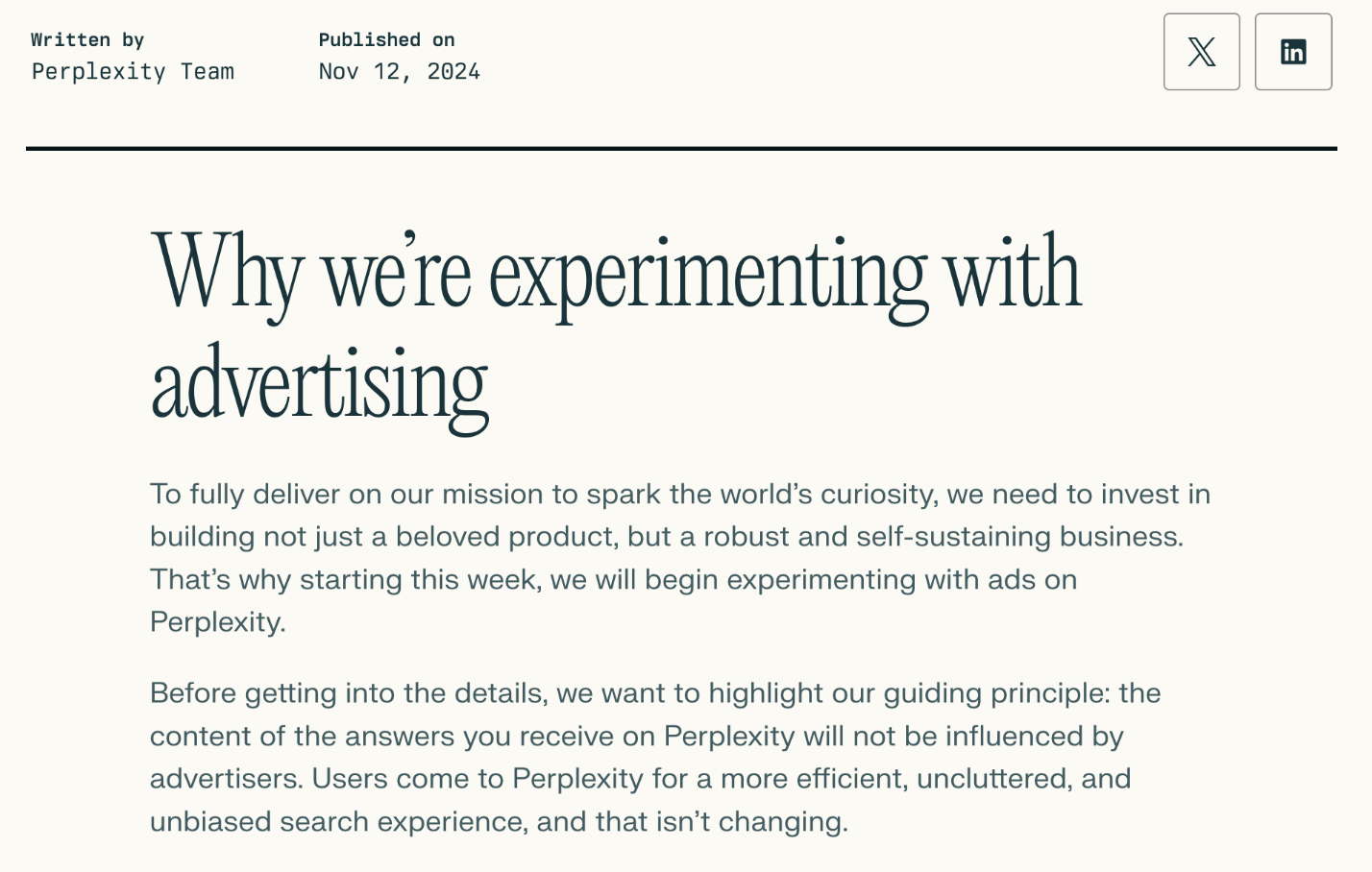Advertising, AI, and the Political Economy of Media and Communications
Matthew Crain / Miami University

In my previous essay for Flow, I argued that researchers should pay close attention as new “AI” companies move to incorporate advertising into their products. I keyed in on the AI-powered search engine Perplexity, which announced its intention to sell ads after seeing rapid user growth in 2024. My position was that it is necessary to “critically examine not only how advertising will be integrated into next gen information technologies, but why. Why is it, exactly, that media and communication technologies always seem to become vehicles for advertising?”
A prosaic answer to the question of “why advertising?” is that advertising is simply the media and internet’s default business model. Any company that aggregates human attention is bound to package and sell it to brands that want to reach consumers. But of course, advertising is not a natural phenomenon. And though the internet is deeply bound up with data, it is not somehow predisposed to collect and process it for targeted consumer sales pitches.
In this follow-up essay, I outline a few threads from the political economy of media and communications (PEMC) research tradition that point toward more substantive and critical answers to why advertising is seemingly on the fast track to inclusion in the next generation of AI internet applications.
Broadly speaking, PEMC provides theoretical and methodological frameworks to examine the interplay between economic structures, political power, and media and communications systems. It investigates how media ownership, policy formation, and business models influence content, access, consumer surveillance, and ultimately, social and political outcomes. PEMC foregrounds historical developments, recognizing that current practices and structures are shaped, incentivized, and constrained by past actions and policy choices. This helps to denaturalize the present, pointing to moments of historical contingency and highlighting the pressures and limits that political economic structures place on human activities. As such, PEMC offers a useful lens for decentering and perhaps challenging advertising’s role as the taken-for-granted economic driver of media and communications systems.
Theories of information commodification provide one entry point. What the late Vincent Mosco (1996) called “extensive commodification” points to capitalism’s process of expanding the terrain of profit-making to “areas such as public education, government information, media, culture, and telecommunication” that once wholly or partially operated in service of goals outside of capital accumulation.[1] Scholars working in the PEMC tradition have documented and challenged the commodification of information, media, and audiences, showing how advertising functions as a means to bring cultural production and human connection into the churn of surplus value extraction. This is not a natural or predetermined process, but rather a systematic transformation driven by capital’s persistent need to expand.
Commodification provides a powerful frame for understanding how ads seem to encroach into ever greater areas of cultural life and explains how information and communication services tend to quickly fill to the brim with “words from our sponsor.” Consider the basic statistical trends of commercial minutes squeezing out programming minutes in broadcast and cable television over time. Consider the rapid proliferation of advertising on the new distribution channel of streaming television, which had been heralded as a bastion of creativity, in part, due to its freedom from advertising pressures. Consider the proto-internet, where marketers were wary to tread bulletin boards and other virtual communities lest they be “flamed” by militantly non-commercial early adopters. Today, of course, the internet is overrun with ads.
Commodification is not only about transforming “use values” to “exchange values,” but also about undermining alternatives, a process Mark Andrejevic has called “digital enclosure.” In practical terms, this means that building a robust and sustainable information service without advertising funding has become a significant challenge. PEMC draws attention to public policy here. A rich tradition of scholarship shows the key role of politics in setting up legal and regulatory regimes that privilege advertising funding models and delegitimize market-based options like subscription services as well as non-commercial structures such as public funding. Radio, television, and the internet were all variously debated by policy-makers, lobbyists, and, to a lesser extent, citizens during early periods of contingency (or “interpretive flexibility”) before coalescing around advertising’s primacy at the behest of marketers hungry to generate consumer demand.
Arguably, Perplexity’s options were severely constrained by political economic structures long before its first employee wrote a single line of code. Americans have been conditioned over time to expect “free media” subsidized by advertising, and a dedicated business lobby has successfully undermined popular understanding and appetite for publicly funded, non-commercial alternatives. Like the fledgling companies at the forefront of the late 1990s dotcom bubble, today’s AI startups are compelled by their venture capital funders to “get big fast” and monetize the attention of audiences despite the well-known risks of undermining the integrity of their products. A mold has been set.
This is where PEMC has sometimes found trouble with critics who have characterized its emphasis on structures and historical development as economic determinism, which downplays the very real human agency that has always been at play in media production and consumption, as well as the attending political processes that shape media and communications systems. This is an important critique that many PEMC scholars have taken seriously, and, as a result, more synthetic approaches have been developed. We’ve come a long way since 1995, but questions of structure and agency remain thorny.

Shortly after my first essay was published, Perplexity’s own PR team weighed in via a blog post titled “Why we’re experimenting with advertising.” (Someone call my dean: does this count as “evidence of impact” for academic work?).
Perplexity’s commentary presents an opportunity to make a classic move in PEMC research: using primary sources to “listen in” to what companies say about their actions, motivations, and commitments in order to map out how specific practices, such as selling ads against AI-based search results, are discursively constructed. As T.C. Corrigan writes, PEMC researchers “use history and theory to interpret specific empirical data”—what companies do and how they talk about it—as “manifestations of underlying structural processes” and contradictions in capitalism.[2]
There is a lot to unpack in Perplexity’s announcement, especially when juxtaposed with the leaked slide deck that introduced the advertising program to potential business customers a few months prior. While the deck was a sales tool meant to drum up advertising business, the blog post is intended for Perplexity’s users. The post begins: “To fully deliver on our mission to spark the world’s curiosity, we need to invest in building not just a beloved product, but a robust and self-sustaining business. That’s why starting this week, we will begin experimenting with ads on Perplexity. Before getting into the details, we want to highlight our guiding principle: the content of the answers you receive on Perplexity will not be influenced by advertisers [emphasis added]. Users come to Perplexity for a more efficient, uncluttered, and unbiased search experience, and that isn’t changing.”

Note the defensive posture right from the start. This is clearly not a pitch to users about how advertising will improve Perplexity’s products. It’s a much more oblique argument that insists on advertising’s necessity while admitting to, and hedging against, its destructive potential. The company is tiptoeing backwards into advertising with an apology-promise: sorry we invited a vampire in the house, but it’s going to help pay the mortgage. We will keep it confined to the basement. We promise.
There are obvious limits to what can be gleaned from listening in to just a few corporate documents. Absent further qualitative research and interpretation, we cannot make determinative judgments about how and why Perplexity’s leaders came to their decision to bring ads onboard. But the dilemma revealed in Perplexity’s blog post is perennial: a structural problem of the media. For all of capitalism’s innovative potential, the pressures of advertising remain as strong as ever, waiting in anticipation. Just beyond the threshold.
Note: This essay is dedicated to the memory and work of Robert McChesney. Bob was a leading scholar in the PEMC tradition, a fierce advocate for democratic media systems, and a generous mentor to many. Rest in power, Bob.
Image Credits:
- Perplexity AI
- Experiment with advertising (author’s screen grab)
- Perplexity Ads
This essay offers a sharp analysis of why advertising defaults as the business model for new media technologies, particularly with Perplexity AI. The author skillfully employs the Political Economy of Media and Communications (PEMC) framework to explain the “commodification of information” and underlying economic structures. This is a crucial and timely analysis, deepening our understanding of the drivers behind technology and business models in the AI era.